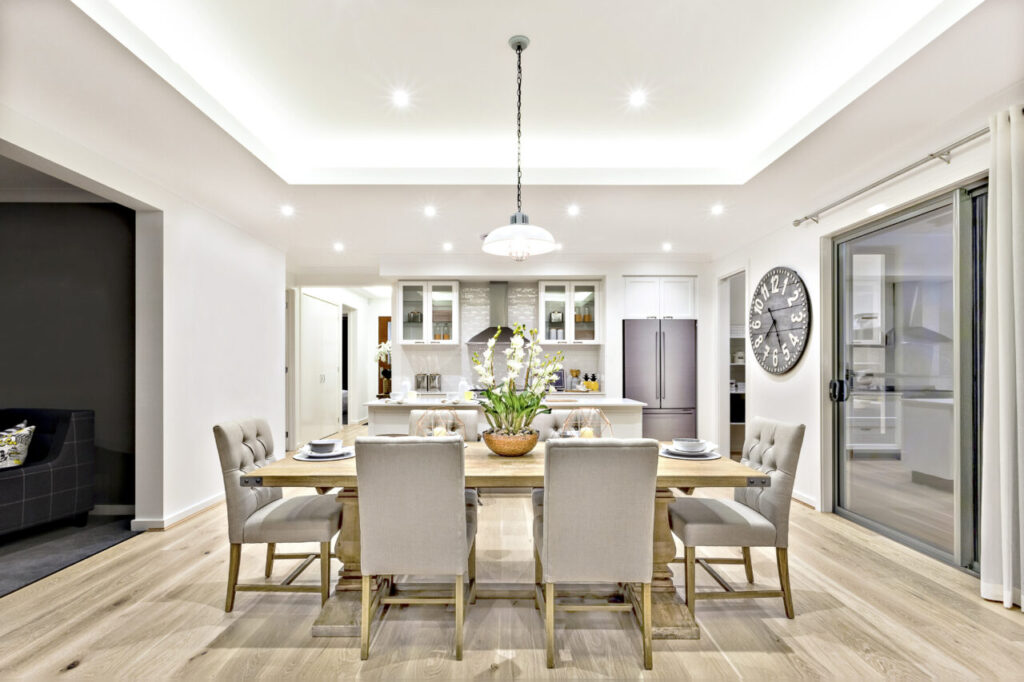Americans seem to need comfortable, relaxing living spaces more than ever. Studies find that over 60% of Americans say their stress levels are at an all-time high, and many are desperately searching for relief. One of the best ways to find it is by turning your home into a sanctuary – particularly often neglected but important spaces such as the dining room.
But it’s about more than just stress relief. Making your dining room tranquil, cozy, and welcoming is also an easy way to encourage your family to have meals together, a habit that experts agree comes with many benefits. There’s a potential financial upside, too. Homes with well-designed communal spaces are more appealing to buyers. Leveling up your dining room now could help you find a better or faster offer (or even sell without an agent) when you decide to put your home on the market.
Let’s take a closer look at some of the best ways to make your dining area tranquil and comfortable.
Pick Pleasing Colors
Color is incredibly important for the look and feel of a room. Bright vivid colors like some reds can be striking but also harsh on the eye or even speed up your heart rate. On the other hand, certain colors have the opposite physiological effect, like pink, which induces calmness but can be hard to look at every day.
Most design experts suggest a muted, neutral palette for your dining room; think beige, off-white, taupe, light grey, or similar tones. Generally, it’s best to stay away from flat white. While it may sound neutral, it can be hard on the eyes and shows signs of age and wear faster.
Get the Floors Right
Natural materials have the most soothing energy, so you should opt for a simple hardwood floor in your dining room. They’re durable, easy to clean, and visually appealing, a timeless choice that suits nearly any home.
On top of that hardwood, consider putting down some rugs. They’ll soften the floors, both literally and visually, and add a touch of color. Be mindful of rug placement; if you have a large dining room, you can strategically use rugs to separate different spaces. If you’re putting a rug under the table, ensure it’s washable and large enough that chairs can slide away from the table without leaving the carpet.
Use Textures
Layer your space with visually interesting textures. Velvet drapes can add weight to your windows, while heavy pile rugs can make your floors seem warmer. If your walls feel bare, consider adding art or wall hangings. Furniture can also be textured, including options like wicker or rattan. Just don’t go overboard – a little texture in a room goes a long way.
Create Focal Points
Minimalism has its place, but an overly sparse dining room isn’t a good choice for creating a welcoming atmosphere. Strategically deploy items to create a few focal points around the dining room, such as a chair and lamp in a corner or a mosaic of family photos on the wall. Still, take care not to clutter up the room.
Add Greenery
Plants and flowers are an excellent way to add life and color to a room. You don’t need to spend a lot of money on a big flower arrangement; a few cuttings from your yard can freshen up the room just as effectively. If you don’t have much of a green thumb, consider hardy cacti or succulents for a low-maintenance, long-lasting option.
Avoid Sharp Angles
Tables with sharp, right-angled corners aren’t conducive to conversation and can even be unsafe for small children. Round or oval tables feel more egalitarian and have a smaller physical footprint than a square or rectangular table of the same capacity. That makes them particularly well-suited for smaller dining rooms. Those with big families or who routinely host large gatherings may want to opt for an oblong oval table or a round one with an extension leaf in the middle.
Set the Mood With Lighting
Often, natural lighting is the best lighting, so make sure your dining room windows are clean and unobstructed. If landscaping or the design of your home prevents you from getting much light from your windows, consider removing or reshaping outdoor plants or home renovations like improved windows. Getting natural light in your dining room isn’t just a matter of comfort – selling a home with poor lighting can be as trick as trying to sell a house without a stove in the kitchen.
But you’ll also need lighting after the sun goes down. Keep the light moody and subtle. Instead of harsh overhead lights, consider smaller desk lamps on a console table, larger floor lamps in peripheral nooks or corners, or a series of suspended pendant lamps. Pay particular attention to the light bulbs you use; choose warm yellow light over harsh white or bluish bulbs.
Add Personal Touches
Remember, this is your dining room. It should be designed to please you and your family, not the hypothetical readers of a design magazine or a long-off future buyer. Don’t be afraid to add a personal feel to the room to make it fully yours. Hang cherished art pieces and family photos on the wall, invest in a discreet sound system to play your favorite music while you dine, and burn candles that give off your favorite scents.
The Power of Color: Benjamin Moore’s Paint of the Year and the Psychology of Design


